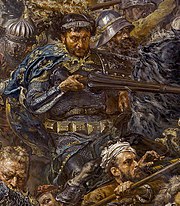
Zawisza Czarny in a detail of Jan Matejko's Battle of Grunwald
Zawisza Czarny z Garbowa (Zawisza the Black of Garbów, also known as the Black Knight; c. 1379 in Stary Garbów, Poland – 1428 in Golubac, Serbian Despotate), Sulima Coat of Arms, was a Polish knight and nobleman. He served as a soldier and diplomat under the Polish king Władysław II and Hungarian-Bohemian king Sigismund of Luxembourg. During his life, he was regarded as a model of knightly virtues and was renowned for winning multiple tournaments. His nickname is due to his black hair and his custom-made, black armor, which is kept at the Jasna Góra Monastery.
Life[]
Origin[]
|
|
This section is empty. You can help by adding to it. |
1410-1419[]
In 1410 he took part in the Battle of Grunwald against the Teutonic Order. After the battle he proposed a peace treaty between the King Jagiełło of Poland and King Sigismund of Luxembourg of Hungary, which came to be known as the Treaty of Lubowla. In 1412 he participated in the conference between Sigismund, Wladyslaw II and Tvrtko II of Bosnia at Buda, where he won the tournament held there, with 1500 knights present.
Zawisza was a diplomat as often as a warrior, being many times an envoy for the Polish king Władysław II and Hungarian-Bohemian king Sigismund of Luxembourg. As one of six diplomats that represented the Polish Kingdom and king Władysław Jagiełło at the Council of Constance, where he was one a very few supporters of the church reformer Jan Hus and consequently strongly opposed his condemnation and subsequent execution.
In 1416 he participated in a tournament in Perpignan in which he defeated the well-known knight John of Aragon. The following year, he became the starosta of Kruszwica. In 1419 he went to Sigismund again, as a deputy of King Jogaila, to ask for the hand of Ofka, the widow of Sigismund’s brother Wenceslaus King of Bohemia. Subsequently, Zawisza participated in the Hussite Wars on the side of king Sigismund. During Sigismund’s defeat at Kutná Hora, Zawisza was taken prisoner by the Czechs and subsequently released in return for a high ransom.
War against Ottomans and death[]
In 1428, Zawisza, with his retinue as a commander of light horse banner of 500 horsemen, joined the forces of Sigismund in the king's war against the Ottoman Turks. During that disastrous campaign he fought the Turks at the Siege of Golubac on the Danube in modern-day Serbia. Sigismund army was defeated by the Turkish forces. They had to retreat across the Danube, with only a few boats to ferry the troops over to safety. Zawisza's banner was guarding the retreating army. Being a man of importance, he was personally sent for by king Sigismund. He allegedly refused to retreat, disheartened by king's apparent cowardice. He was either killed in combat or executed in Turkish captivity.
He was survived by his wife, Barbara of Badolino, Pilawa coat of arms, and four sons: Zawisza, Jan (killed at the battle of Chojnice), Marcin and Stanislaw (the last two killed at the battle of Varna); and a daughter, probably also named Barbara. His granddaughter, Barbara of Roznow, was the mother of the Polish Renaissance military commander, hetman Jan Tarnowski.
Legacy[]
After his death, he was praised by the Polish historian Jan Długosz, the poet and Canon of Gniezno Adam Świnka, and by King Sigismund of Luxembourg. Zawisza became a folk hero in Poland, famed for reliability, and loyalty. The Polish Scouts oath reads partly: "...polegać na nim jak na Zawiszy" ('[you can] rely on [a boyscout] as on Zawisza'). A monument to Zawisza at Golubac fortress, Serbia, bears the inscription: "In Golubac, his life was taken by the Turks in 1428, the famous Polish knight, the symbol of courage and honor, Zawisza the Black. Glory to the hero!" Several Polish football clubs and other sports teams were named after him, including, Zawisza Bydgoszcz.
References[]
| Wikimedia Commons has media related to Zawisza Czarny z Garbowa. |
- Polski Słownik Biograficzny, Tom VI, biography Farurej Jan z Garbowa, Brother of Zawisza
- Beata Możejko, Sobiesław Szybkowski, Błażej Śliwiński: Zawisza Czarny z Garbowa herbu Sulima, Gdańsk 2003, Wydawnictwo WiM, ss. 136, ISBN 83-918873-4-0
The original article can be found at Zawisza Czarny and the edit history here.